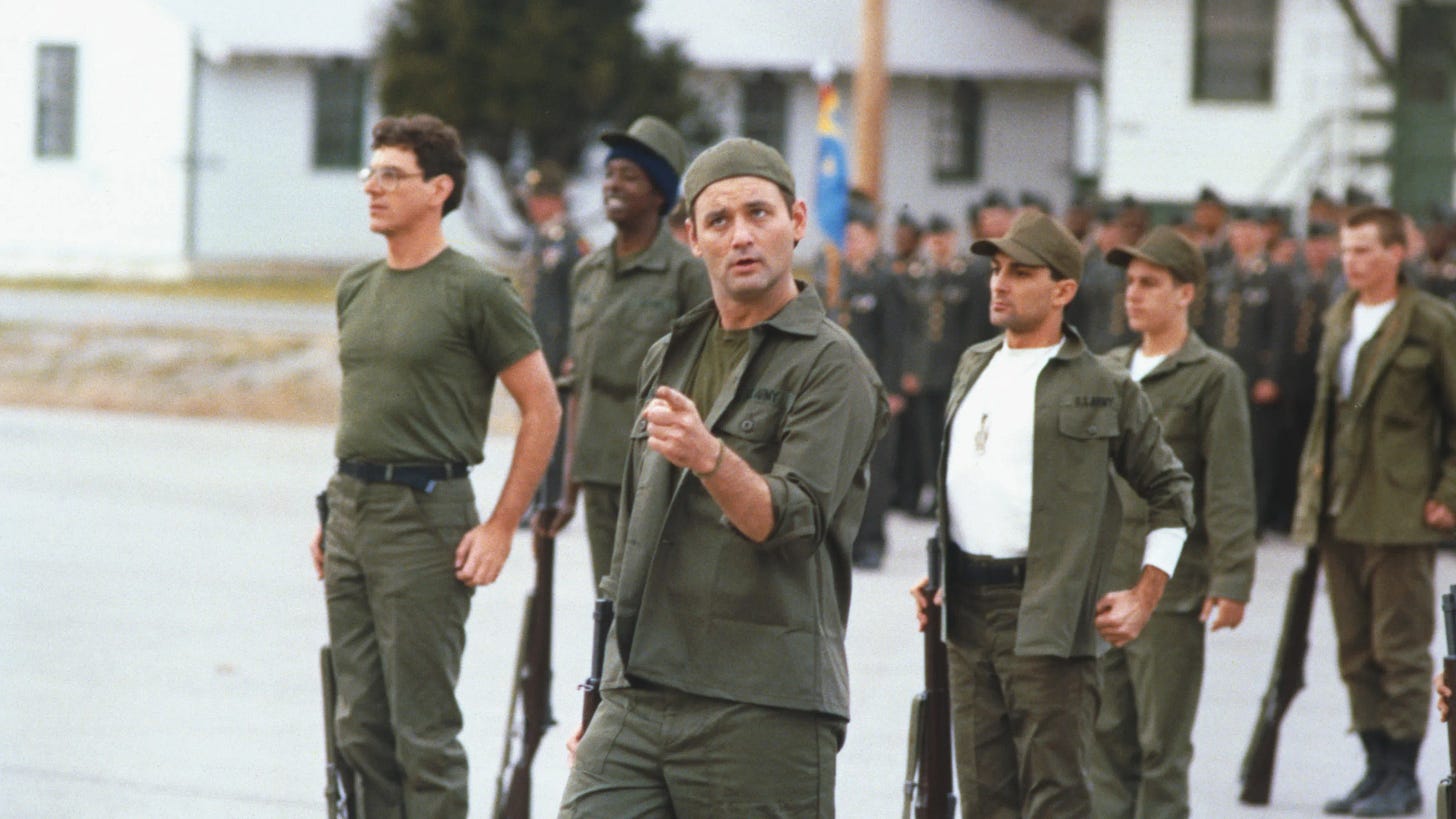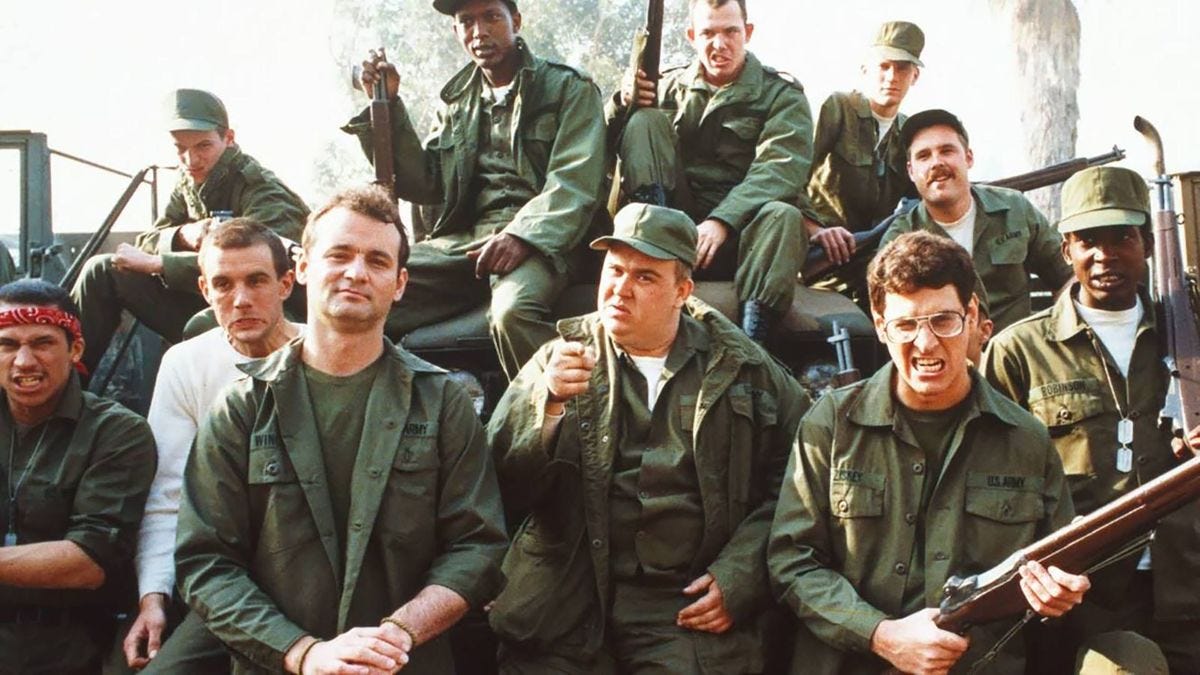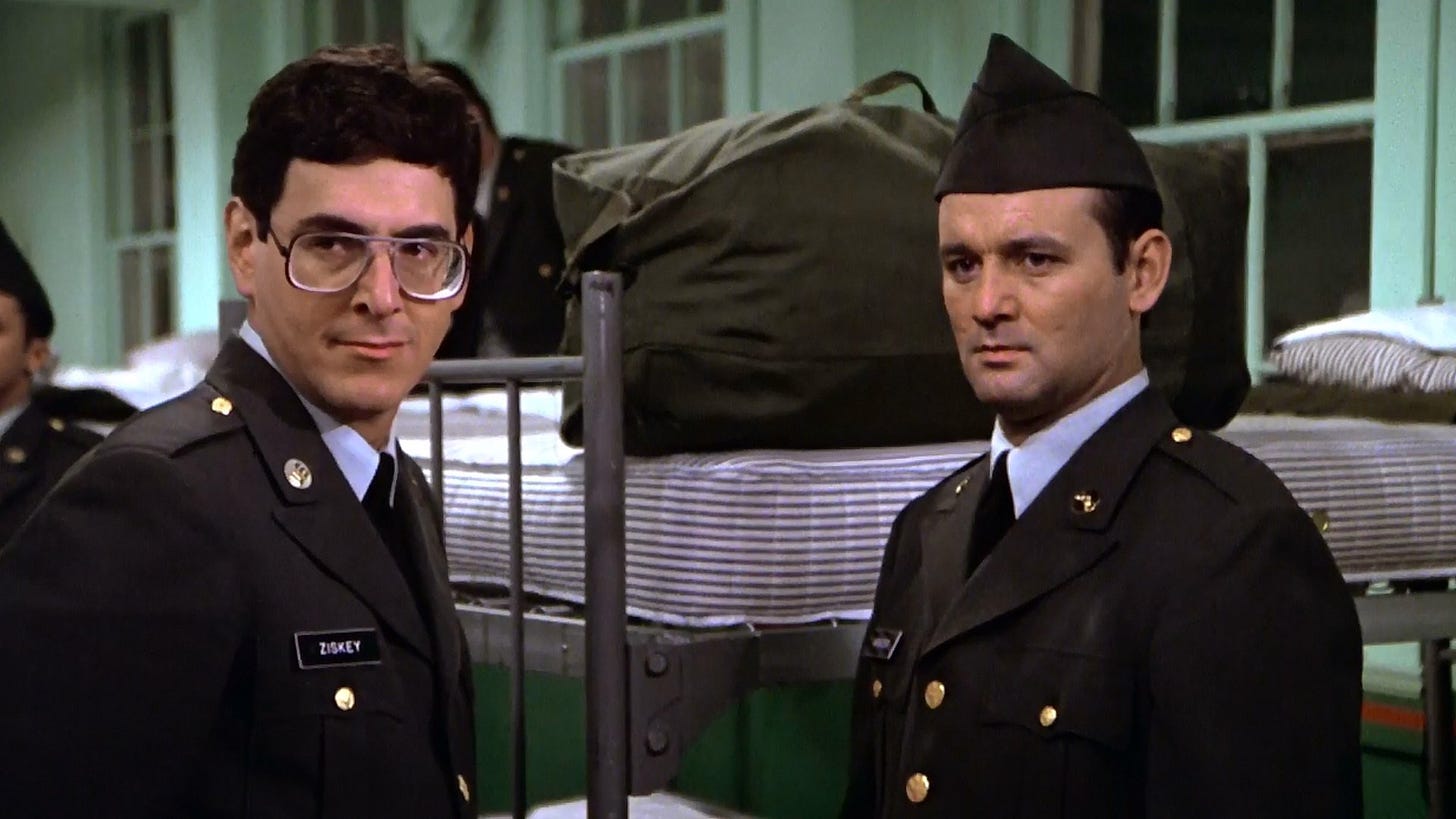The '80s in 40: ‘Stripes’ (June 26, 1981)
'Stripes' helped confirm Bill Murray as a movie star by packaging his rebelliousness in a fundamentally safe comedy filled with half-hearted jabs at authority.
The ’80s in 40 revisits the decade of the 1980s choosing four movies a year, one from each quarter. This entry covers the third quarter of 1981.*
For five seasons from 1964 and 1969, CBS aired the sitcom Gomer Pyle, U.S.M.C., an amiable spin-off of The Andy Griffith Show starring Jim Nabors as a small-town yokel who enlists in the Marine Corps and Frank Sutton as the tough-but-compassionate Sergeant Carter he drives to frustration. One of the most popular shows of its era, ending only because Nabors wanted to move on, Gomer Pyle aired as the Vietnam War escalated but never mentioned the conflict. That doesn't mean the war wasn’t on the minds of those who made it. When Nabors died in 2017, The Hollywood Reporter’s obituary noted the star “had trouble watching Pyle‘s opening credits when the series was playing in syndication because many of the Marines with whom he marched were killed in Vietnam.”
The changes that swept across comedy in the 1970s seemed like they might consign that kind of divide between fantasy and reality to the past. From Norman Lear bringing topicality to primetime sitcoms to the counterculture finding an after-hours TV anchor via Saturday Night Live, the time for gentle escapism seemed like it had ended. At the very least, comedies as out-of-touch and blithe about the dangers of military service as Gomer Pyle could never happen again. Unless, that is, they took on a slightly edgier form.
In the 1980 comedy Private Benjamin, Goldie Hawn stars as Judy Benjamin, a woman from a Philadelphia family of means nearing the end of her twenties who’s thrown into an identity crisis when her second husband (Albert Brooks) dies on their wedding night. A solution unexpectedly arrives in the form of Jim Ballard, a kindly U.S. Army recruiter played by Harry Dean Stanton, who woos Judy with pictures of the private condos and yachts found on a base in Monterey, California. But mostly he pushes her in the direction she was already headed by presenting the army as a place where she can find who she really is and where she can take on one of over 300 different jobs, one of which must surely be her true calling. “You can forget that old brown boot image of the Army,” he tells her. “It’s the Army of the ’80s. You’ll love it.”
Judy quickly discovers that she’s been given a soft sell, that boot camp and the daily grind of Army life don’t quite match up with the pamphlets she’s been shown and that she has to deal with vindictive superiors and sexual harassment. Yet, on another level, Ballard was telling the truth. The army becomes a proving ground that hardens Judy up and lets her be her best self (even if she eventually leaves it behind). That the film appeared the same year the U.S. Army debuted its long-lived “Be All You Can Be” campaign is surely a coincidence, but Private Benjamin is largely on message anyway. One year later, so was Stripes.
Conceived by director and co-writer Ivan Reitman as a vehicle for Cheech Marin and Tommy Chong, Stripes stalled out in its original incarnation when the comedy team wanted to exert creative control. Rather than letting the project die, Reitman and co-writers Len Blum and Dan Goldberg reworked it to suit Bill Murray, slotting Harold Ramis into the sidekick slot in an attempt to attract Murray’s interest and to have a Murray-friendly writer on set at all times.
Murray had only appeared in a handful of films at the time, most notably Meatballs (also made with Reitman, Blum, and Goldberg) and Caddyshack. Released just a little over year after his final episode of Saturday Night Live, Stripes is arguably Murray’s first film as a true lead (though a case could be made for Meatballs). Everyone involved rested the whole film on his shoulders and expected him to carry it, which he does. Murray made many movies after Stripes, but it’s the Bill Murray-est movie imaginable. Every scene features variations on Murray’s now-familiar comic persona: the checked-out sarcasm, smirking rebelliousness, muttered wisecracks, flirtatious charm, hints of soul-deep despair, and mock sincerity that has a way of slipping into genuine sincerity with little warning. The film couldn’t work without him.
It barely works with him. Stripes provides Murray with a comic showcase, but it also captures how shapeless and ultimately meaningless the Bill Murray character can be in a film that doesn’t know what to do with him, other than let him loose and see what happens. The film opens in the nameless city where Murray’s John Winger works as a cab driver (actually Louisville; much of the film was shot in Kentucky). Following a funny confrontation with a snobby dowager straight out of a studio comedy from decades before, Winger loses his job, his car, the pizza he’d planned to eat for dinner, and his girlfriend, leaving him alone in an apartment filled with remnants of a photography career that’s never really taken off.
After watching an Army recruitment ad, Winger sees a chance for a fresh start and ropes his pal Russell Ziskey (Ramis) into the plan. Until they sign the papers, it doesn’t seem entirely clear to either if they’re really going to go through with it or back out at the last minute as a joke. A seemingly ironic interest in joining the Army turns into a real military career because neither of them blinks. The generation that grew up watching Murray saw his ironic detachment as aspirational, but Stripes should have served as a warning that such affectations could take you places you don’t really want to go.
What follows is essentially an old-fashioned service comedy of the sort Abbott and Costello and Martin and Lewis used to make but updated with jokes about drugs and an abundance of nudity. Winger and Ziskey find themselves thrown in with a group of misfit recruits that include Judge Reinhold (as a stoner), John Diehl (as a dummy), and John Candy as Ox, an enthusiastic recruit who hopes to use his time in the service to slim down. Like Winger, he sees the Army as a self-improvement opportunity first. Any other concerns are a distant second.
Once in camp, Winger and Ziskey romance a pair of MPs played by Sean Young and PJ Soles and infuriate the long-serving, no-nonsense drill instructor Sergeant Hulka (Warren Oates). But the real enemy is Captain Stillman (John Larroquette), an inexperienced careerist snob who serves as a fail to the more down-to-earth slobs serving under him. After a string of hijinks (including a trip to Central America in the bloated extended cut), the Winger-led troupe get with the program while putting their own spin on the drill skills needed to graduate. Then the movie just keeps going with a lot of nonsense involving a high-tech RV and a rescue attempt behind some not-very-formidable Czechoslovakians on the other side of the Iron Curtain. The boys almost goof their way into starting World War III, but it’s all in good fun.
What’s important, it seems, is that, like Judy Benjamin before him, Winger comes out the other side knowing who he is. With the help of the Army, he’s found a way to be all he can be. It might be easiest, and maybe even best, not to read too much into this, to complain that it belittles the gravity of military service or helps to provide the military with an unearned post-Vietnam burnish, a new image for a new decade, though this didn’t go unnoticed at the time. In reviewing the film for the Los Angeles Times, Kevin Thomas noted that its arrival and the success of Private Benjamin suggested “just how completely the moviegoing public has put Vietnam behind it—or maybe just how very young audiences have gotten.”
In doing an already-rare round of press for the film in 1981, Murray also seemed concerned. Speaking to Clarke Taylor, also of the LA Times, he said,“The thing about movies is that people will draw whatever they want from them, so you have to be really aware of what you’re saying and of possible interpretations. […] It’s a problem making a funny movie about the Army without denying the seriousness—and the Army is serious business—yet we didn’t want it interpreted as a propaganda film.” It would be hard to interpret Stripes as propaganda but consider this: it arrived in theater a little over a decade after Robert Altman's M*A*S*H, a film seemingly designed to make lighthearted military romps that ignored the core purpose of the military, and the horrors of war, unthinkable. (Stripes does share an unrepentant sexist streak with Altman’s film, however, unless there’s some point to the endless trip to a mud wrestling club I’m missing.)
Murray’s at the center of it all but he’s also nowhere. Any efforts to depict the ennui that made Winger enlist, or even to make him a character, pretty much ends once the film moves to boot camp. Stripes mostly treats the Army as a convenient and unlikely setting for a wiseacre to go about his wiseacre business. But it’s so slack and shaggy and the lapses between genuine laughs are so long that its commitment to saying nothing becomes its own kind of statement. There’s not much distance between its depiction of the military as, above all, a tool for self-realization and Top Gun’s treatment of service as a quest for awesomeness occasionally interrupted by bloodless combat with faceless, nameless enemies. “We’ve been kicking ass for 200 years,” Winger tells his fellow soldiers in a central pep talk before adding, “We’re 10 and one!” It’s the one moment Stripes goes where Gomer Pyle would never dare.
Next: Body Heat
Heaven's Gate (April 1981)
Cutter’s Way (March 1981)
9 to 5 (December 1980)=
Ordinary People (September 1980)
Urban Cowboy (June 1980)
Little Darlings (March 1980)
* OK, technically Stripes is part of the second quarter of 1981. But the book I rely on to source these columns is sorted by the end of the week, making this a July release. Also, I wanted to revisit Stripes because I assumed I must have been missing something on previous viewings, given its classic status.







Stripes got my high school marching band briefly in trouble. This was around 1983 or 84, when the movie was in heavy rotation on cable. At one point, during a night practice, we were at attention and were being addressed by the drum major. She gave us some sort of command, and, as pre-planned by some group of smart-alecks (I'm guessing it was the trumpet section), we all shouted back, "That's the fact, Jack!"
From my perspective, and I think the rest of the band's, it was an innocent bit of goofballism. And would have likely have been seen as such except for one thing: We were a majority white school, and the drum major was Black. And our band director had no idea or context about the Stripes reference: All he saw was a bunch of white kids (and a handful of Black kids) giving some sass (with an admittedly jive-y tone) to a Black girl. So the band director, bless him, started pacing across the field giving us a dressing-down about racism. IIRC, it was the drum major who talked him down and explained what had happened, and what the reference was, and that our intentions were to surprise her and make her laugh, not to bully her.
It's funny: At the time, that incident represented to me how out-of-touch our band director was with the kids he was teaching. But looking back on it now, I just think of what a good man he was, stepping right up to address a perceived injustice.
Years ago, me saw Bill Murray do Q&A with Elvis Mitchell, who asked about him ad-libbing on set. He said he not really have to since Rushmore, because he gets good scrips, but on early movies, he would get script pages in morning and think, "well, we obviously not filming this bullshit." And me remember two movies he singled out in that story were Meatballs and Stripes.